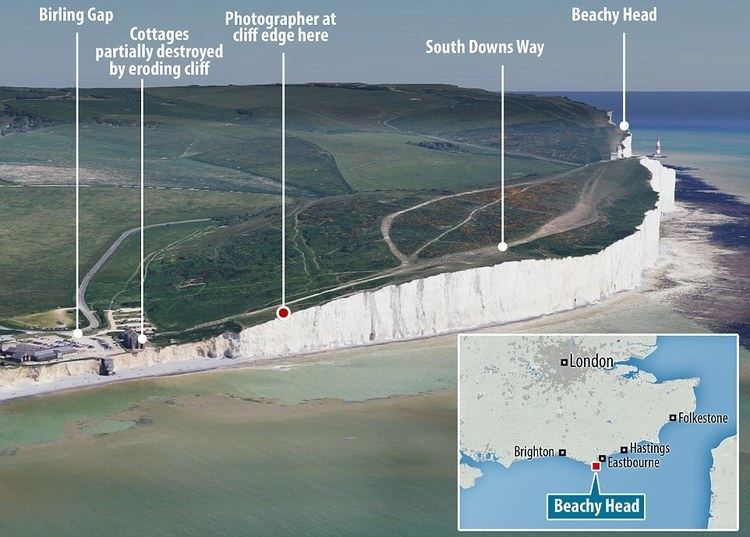 | ||
Similar Seven Sisters - Sussex, Belle Tout lighthouse, White Cliffs of Dover, Cuckmere Haven, Beachy Head Lighthouse | ||
Beachy head in 4k by drone
Beachy Head is a chalk headland in East Sussex, England. It is situated close to Eastbourne, immediately east of the Seven Sisters.
Contents
- Beachy head in 4k by drone
- Geology
- History
- Lighthouse
- At war
- Tourism
- Suicide spot
- In film
- In literature and publications
- In music
- In television
- References
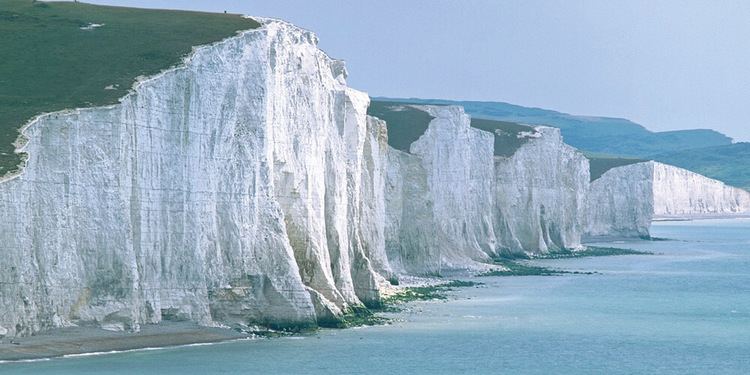
Beachy Head is located within the administrative area of Eastbourne Borough Council which owns the land. The cliff is the highest chalk sea cliff in Britain, rising to 162 metres (531 ft) above sea level. The peak allows views of the south east coast from Dungeness in the east, to Selsey Bill in the west. Its height has also made it one of the most notorious suicide spots in the world.
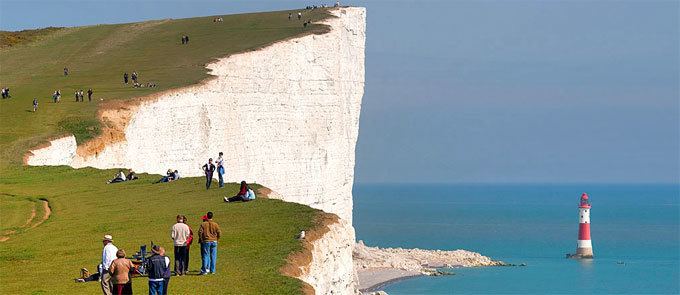
Geology
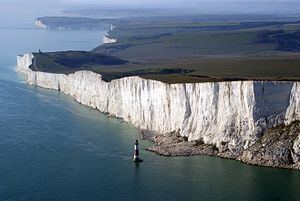
The chalk was formed in the Late Cretaceous epoch, between 66 and 100 million years ago, when the area was under the sea. During the Cenozoic Era, the chalk was uplifted (see Cenozoic Era). When the last Ice Age ended, sea levels rose and the English Channel formed, cutting into the chalk to form the dramatic cliffs along the Sussex coast.
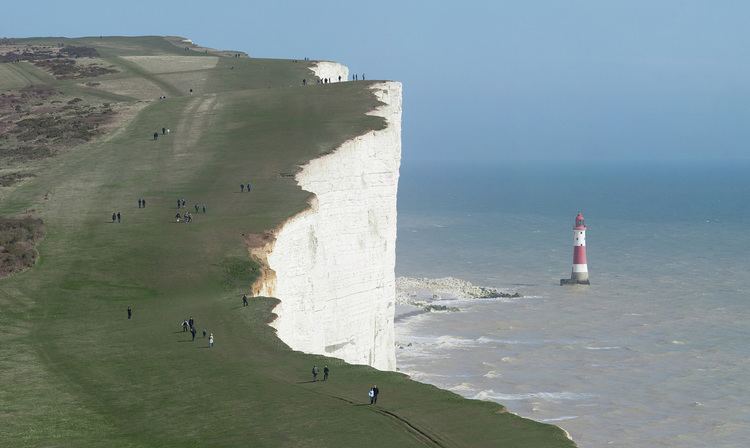
Wave action contributes towards the erosion of cliffs around Beachy Head, which experience frequent small rock falls. Since chalk forms in layers separated by contiguous bands of flints, the physical structure affects how the cliffs erode. Wave action undermines the lower cliffs, causing frequent slab failures - slabs from layers of chalk break off, undermining the upper parts of the cliffs, which eventually collapse. In contrast to small rock falls, mass movements are less common. A mass movement happened in 2001 when, after a winter of heavy rain, the water had begun to seep into the cracks which had frozen and caused the cracks to widen. This then made the cliff edge erode and collapse into the sea, destroying a well-known chalk stack called the Devil's Chimney.
History
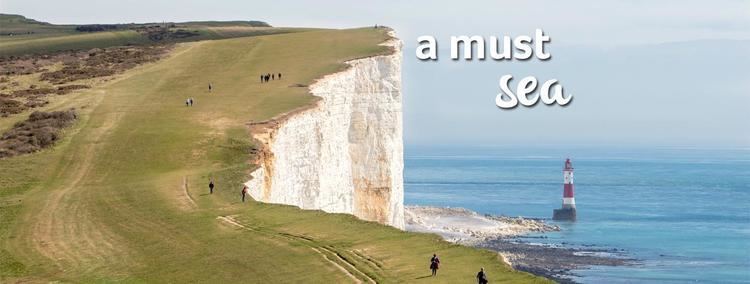
The name Beachy Head appears as 'Beauchef' in 1274, and was 'Beaucheif' in 1317, becoming consistently Beachy Head by 1724, and has nothing to do with beach. Instead it is a corruption of the original French words meaning "beautiful headland" (beau chef).

In 1929 Eastbourne bought 4,000 acres (16 km2) of land surrounding Beachy Head to save it from development at a cost of about £100,000.
The prominence of Beachy Head has made it a landmark for sailors in the English Channel. It is noted as such in the sea shanty Spanish Ladies:
"The first land we sighted was called the Dodman,Next Rame Head off Plymouth, off Portsmouth the Wight;We sailed by Beachy, by Fairlight and Dover,And then we bore up for the South Foreland light."The ashes of German social scientist and philosopher Friedrich Engels, one of the fathers of communism, were scattered off the cliffs at Beachy Head into the Channel, as he had requested.
Human remains discovered in the 1950s were later subjected to forensic reconstruction, carbon dating, and radio-isotype analysis, and found to be those of a woman of Sub-Saharan origin who grew up in the Eastbourne area in about 200-250CE. She has become known as Beachy Head Lady.
Lighthouse
The headland was a danger to shipping. In 1831, construction began on the Belle Tout lighthouse on the next headland west from Beachy Head. Because mist and low clouds could hide the light of Belle Tout, Beachy Head Lighthouse was built in the sea below Beachy Head.
At war
The third day of fighting in the Battle of Portland in 1653 took place off Beachy Head during the First Anglo-Dutch War. The Battle of Beachy Head in 1690 was a naval engagement during the Nine Years' War. The so-called Second Battle of Beachy Head took place over a week in September 1916 during the First World War. Three German U-Boats sank 30 merchant ships between Beachy Head and the Eddystone. This was despite a major effort involving the Royal Navy and 49 destroyers, 48 torpedo boats, seven 'Q' ships and 468 auxiliaries.
During the Second World War, the Royal Air Force (RAF) established a forward relay station at Beachy Head to improve radio communications with aircraft. In 1942, signals were picked up at Beachy Head which were identified as TV transmissions from the Eiffel Tower. The Germans had reactivated the pre-war TV transmitter and instituted a Franco-German service for military hospitals and VIPs in the Paris region. The RAF monitored these programmes, hoping (in vain), to gather intelligence from newsreels. There was also an important wartime radar station in the area and, during the Cold War, a radar control centre was operational in an underground bunker from 1953 to 1957.
Tourism
West from Belle Tout, the cliffs drop down to Birling Gap, then ascend through the Seven Sisters to Haven Brow, overlooking the Cuckmere valley. The area is a popular tourist attraction. Birling Gap has a restaurant and, in the summer, multiple ice cream vans serve the area.
Suicide spot
There are an estimated 20 deaths by suicide a year at Beachy Head. The Beachy Head Chaplaincy Team conducts regular day and evening patrols of the area in attempts to locate and stop potential jumpers. Workers at the pub and taxi drivers are also on the look-out for people contemplating suicide, and there are posted signs with the telephone number of the Samaritans urging potential jumpers to call them.
Deaths at the site are well-covered by the media, and Ross Hardy, the founder of the chaplaincy team, says that this encourages suicidal people to choose the site. Worldwide, the landmark's suicide rate is surpassed only by the Golden Gate Bridge in San Francisco and the Aokigahara Woods in Japan, according to Thomas Meaney of The Wall Street Journal (although this claim is challenged by other data on famous suicide spots around the world).
Between 1965 and 1979, there were 124 deaths at the location. Of these, S J Surtees wrote that 115 of them were "almost certainly" suicides (although a coroner's verdict of suicide was recorded in only 58 cases), and that 61 percent of the victims were from outside East Sussex. The earliest reports of deaths come from the 7th century. After a steady increase in deaths between 2002 and 2005, there were only seven fatalities in 2006, a marked decrease. The Maritime and Coastguard Agency, whose Coastguard Rescue Teams are responsible for the rescue of injured jumpers and the recovery of the deceased, attributed the reduction to the work of the Chaplaincy Team and good coverage of services by the local media. At least 26 people died at the site in 2008.
